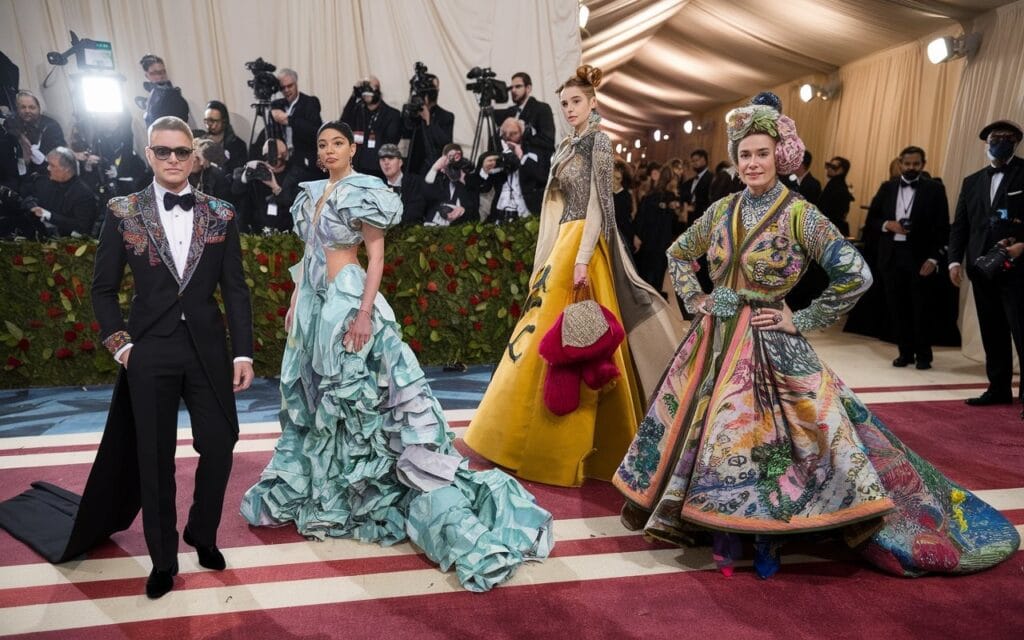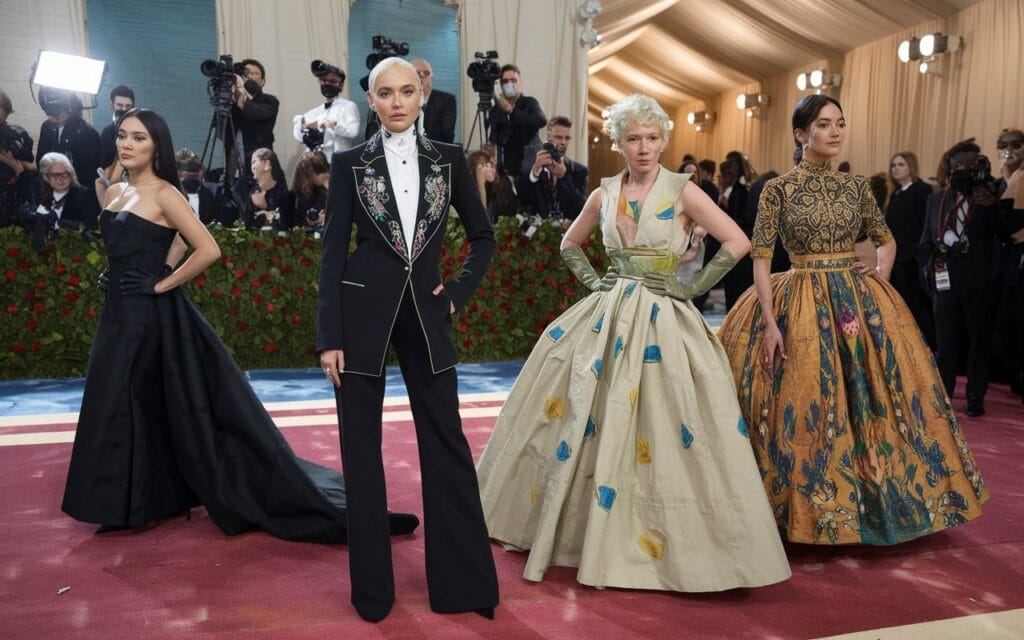Introduction
Red carpets have long been synonymous with glamour, offering a dazzling showcase of fashion, creativity, and personality. However, the concept of glamour itself has evolved significantly over time. Gone are the days when red-carpet appearances strictly adhered to rigid norms of elegance. Today, celebrities are rewriting the rules, blending bold innovation with meaningful representation.
The red carpet isn’t just a runway for designer outfits; it’s a stage where culture, politics, and individuality take center stage. But how did we get here? And why does this evolution matter in pop culture?
Influence of Old-Hollywood Icons
The golden age of Hollywood (1930s–1950s) defined classic red-carpet fashion. Stars like Audrey Hepburn, Grace Kelly, and Marilyn Monroe epitomized elegance with their tailored gowns, pearl necklaces, and immaculate hairstyles. Their looks were designed to complement the fantasy of cinema, making them aspirational yet accessible to fans.
Signature Styles That Defined an Era
During this period, designers like Christian Dior and Hubert de Givenchy became synonymous with the red carpet. Hepburn’s famous “Breakfast at Tiffany’s” black dress and Monroe’s iconic white halter dress reflected a timeless aesthetic. The focus was on perfection—symmetry, understated glamour, and elegance ruled supreme.
The Arrival of Avant-Garde Fashion
Challenging Norms in the 70s and 80s
As cultural revolutions swept across the world, the red carpet began to reflect societal change. Celebrities started experimenting with bold colors, unconventional cuts, and daring accessories. Think Cher’s feathered Bob Mackie ensemble or David Bowie’s androgynous outfits—each look challenged the norms and paved the way for future fashion innovators.
H3: Iconic Looks That Made Headlines
These decades also saw the rise of controversial outfits. Madonna’s infamous “Like a Virgin” MTV outfit may not have debuted on a traditional red carpet, but its impact rippled through award shows and premieres. Glamour was no longer just about beauty; it was about making a statement.

How Modern Celebrities Are Transforming Red Carpet Glamour
Breaking Gender Norms in Fashion
Gender-Fluid Styles on the Red Carpet
Fashion is no longer confined by gender boundaries, and celebrities like Billy Porter, Harry Styles, and Ezra Miller are leading the charge. Porter’s tuxedo gown at the Oscars and Styles’ lace Gucci jumpsuits challenge traditional ideas of masculinity, proving that fashion is for everyone.
Famous Celebrities Leading the Trend
Other stars, including Kristen Stewart and Tilda Swinton, continue to embrace androgynous fashion, opting for suits, bold patterns, and tailored silhouettes. This shift not only sparks conversations about gender but also opens doors for more inclusivity in the fashion industry.
Embracing Sustainable Fashion
The Role of Eco-Friendly Designers
Sustainable fashion has become a powerful statement on the red carpet. Designers like Stella McCartney and brands such as Reformation create eco-conscious gowns that prove style doesn’t have to compromise ethics.
Celebrities Advocating for Green Glamour
Emma Watson and Joaquin Phoenix are among the many stars who wear sustainable outfits to award shows. By championing ethical brands and reusing outfits, they inspire fans and industry professionals alike to rethink the environmental impact of fashion.
Instant Feedback and Its Influence on Fashion Choices
In the age of social media, red-carpet looks are no longer confined to the event itself—they are dissected, praised, or critiqued by millions in real time. Platforms like Instagram and Twitter have amplified the impact of every outfit, allowing fans and critics alike to express their opinions instantly.
This immediate feedback loop has transformed how celebrities and their stylists approach red-carpet fashion. Many outfits are designed with the intention of “going viral,” whether through dramatic silhouettes, intricate detailing, or bold colors. Stars like Zendaya, known for her show-stopping Met Gala looks, and Lady Gaga, who never fails to surprise, understand the importance of being meme-worthy.
How Fans Amplify Unique Styles Through Social Platforms
Social media is also a powerful tool for amplifying unique and unconventional styles. Fans often create hashtags, share edits, and initiate trends based on their favorite red carpet-moments. Rihanna’s iconic yellow Guo Pei gown at the Met Gala in 2015 became a sensation thanks to fan-created memes and commentary.
Moreover, this digital attention extends the lifespan of red carpet looks. Unlike earlier decades when an outfit’s impact was limited to magazines, today’s ensembles live on indefinitely through reposts, articles, and fashion retrospectives.
Traditional Outfits on the Global Stage
Cultural representation has become a cornerstone of modern red carpet fashion. Celebrities like Priyanka Chopra Jonas and Lupita Nyong’o have embraced their heritage, often wearing designs inspired by traditional Indian or African aesthetics. These moments are not just visually stunning—they’re a celebration of global cultures that resonate with fans worldwide.
Designers from Underrepresented Communities
More designers from underrepresented communities are now gracing the red carpet, thanks to celebrities who champion their work. Stars like Yara Shahidi and Tracee Ellis Ross often collaborate with Black-owned fashion houses, while international icons like BTS highlight South Korean designers, showcasing the global nature of fashion today.
Celebrity Collaborations That Promote Inclusivity
Inclusivity is also evident in celebrity-designer collaborations. When Beyoncé collaborated with Balmain to create her Coachella outfits, it was a celebration of Black culture on a global stage. Such partnerships allow stars to merge personal identity with high fashion, creating memorable moments that redefine glamour.

The Power of Statement-Making Looks
Political and Social Messages Through Fashion
Key Examples of Activist Looks
Fashion has always been a medium for expression, but today’s red-carpet looks often carry bold political or social messages. For example, Natalie Portman wore a Dior cape embroidered with the names of female directors snubbed by the Oscars, drawing attention to gender disparity in Hollywood. Similarly, AOC’s “Tax the Rich” gown at the Met Gala sparked widespread debate about wealth inequality.
The Influence of Bold Statements on Society
These statement-making outfits are more than just clothing—they’re catalysts for important conversations. By wearing pieces that reflect their values, celebrities inspire fans to think critically about issues ranging from climate change to human rights. This trend showcases how glamour can be both fashionable and purposeful.
Risk-Taking with Experimental Styles
Pushing the boundaries of traditional red carpet attire is another way celebrities are redefining glamour. Whether it’s Kim Kardashian’s head-to-toe Balenciaga look or Jared Leto’s replica of his own head, these risks create buzz and demonstrate that fashion is an art form.
Experimental styles often blur the lines between costume and couture, making red carpets feel more like theatrical performances. This shift keeps the audience engaged, ensuring that every event feels fresh and unpredictable.
Conclusion
The red carpet is no longer just a showcase of high-end fashion—it’s a platform for creativity, cultural expression, and social commentary. From embracing gender-fluid styles to championing sustainable fashion, today’s celebrities are redefining what it means to be glamorous.
As red carpet trends continue to evolve, they reflect broader societal changes, proving that fashion is more than skin deep. The future of red carpet glamour promises to be even more inclusive, experimental, and meaningful.
FAQ
1. How has red carpet fashion changed over the decades?
Red carpet fashion has shifted from the classic elegance of Old Hollywood to bold, experimental, and statement-making styles. This evolution reflects changing societal norms and the influence of technology and activism.
2. Which celebrities are the most influential in setting red-carpet trends?
Icons like Rihanna, Zendaya, Lady Gaga, and Billy Porter consistently push boundaries, setting trends with their innovative and impactful choices.
3. Why is sustainable fashion gaining popularity on the red carpet?
With growing awareness of environmental issues, celebrities are advocating for eco-friendly designs to promote sustainable practices in the fashion industry.
4. What role does social media play in shaping red carpet glamour?
Social media amplifies red carpet moments, offering instant feedback, creating viral trends, and extending the impact of iconic looks.
5. How does cultural representation redefine red-carpet fashion?
Cultural representation celebrates diversity, showcasing traditional designs and empowering underrepresented communities through fashion.






